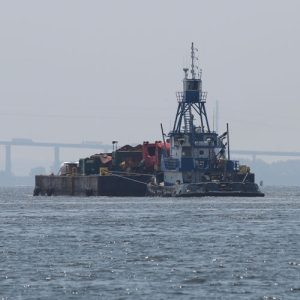
In 2024, an array of events affected business in the Port of Baltimore.
On March 26, 2024, the 984-foot container ship DALI (IMO 9697428) collided with the Francis Scott Key (I-695) Bridge.
The bridge collapsed in the Patapsco River, tragically killing six people. The wreck of the DALI and the remains of the bridge obstructed the navigable channel, crippling the Port of Baltimore.
The loss of the bridge also blocked a critical highway, affecting local commuters and businesses.
Following the disaster, a Unified Command led by the U.S. Coast Guard and the U.S. Army Corps of Engineers removed 50,000 tons of wreckage from the channel. 78 days after the bridge collapse, the port was fully re-opened.
On October 24, 2024, the U.S. Justice Department announced that Grace Ocean Private Limited and Synergy Marine Private Limited, the Singaporean corporations that owned and operated the Motor Vessel DALI, have agreed to pay $101,980,000 to resolve a civil claim brought by the United States for costs borne in responding to the catastrophic collapse of the Francis Scott Key Bridge.
The settlement resolves the United States’ claims for civil damages for $103,078,056 under the Rivers and Harbors Act, Oil Pollution Act, and general maritime law.
According to the announcement, the settlement monies will go to the U.S. Treasury and to the budgets of several federal agencies directly affected by the allision or involved in the response.
On October 29th, officials announced the award of $147 million in U.S. Environmental Protection Agency (EPA) funding to the Port of Baltimore.
The EPA Clean Ports Program funding will go to expedite decarbonization and electrification efforts at the Port.
The funding will enable Maryland Port Administration (MPA) and its private partners to purchase 213 pieces of new zero-emission vehicles, equipment, and charging infrastructure that will replace old, inefficient, and polluting diesel combustion engines.
The funding will also pay for capacity upgrades to the port’s electrical grid, which will help significantly reduce greenhouse gas emissions with an estimated 35% decrease in carbon dioxide equivalency compared to 2020 levels.
Federal grant funding will also support community engagement with neighborhoods such as Turner Station, Brooklyn, and Curtis Bay.
The EPA Clean Ports Program funding is the latest in a series of port improvement projects. Additional improvements include the Dundalk Marine Terminal Reconstruction of Berth 11 and Curtis Creek Drawbridge Rehabilitation and Resiliency projects.
On October 30th, Governor Wes Moore announced the launch of double-stacked rail operations to and from the Helen Delich Bentley Port of Baltimore.
Part of the Howard Street Tunnel Project, the transition to double-stacking containers is expected to create new opportunities for intermodal rail service in the Northeast and from the Port of Baltimore to Midwest markets.
In addition to enhanced transport cost efficiency and enhanced environmental benefits, double-stacking containers will help the Port grow its business by about 160,000 containers annually and will create 13,000 new jobs in construction and in operations.
Double-stacking will also complement the expansion of the Seagirt Marine Terminal where supersized Neo-Panamax cranes service ultra-large container ships.
The completion of vertical clearance improvements at rail bridges north of Baltimore provides CSX the opportunity to operate double-stack rail service on a temporary route from the Port along the CSX network in Pennsylvania, New Jersey, New York and onto the Midwest.
The Howard Street Tunnel Project includes reconstructing the 129-year-old tunnel in Baltimore and 21 other locations in Maryland, Delaware, and Pennsylvania to increase vertical clearance by 18 inches to allow double-stacked container trains to and from the Port of Baltimore
By 2026, when fully complete, the double-stack project will provide the East Coast with seamless double-stack capacity from Maine to Florida.
The Helen Delich Bentley Port of Baltimore’s state-owned public marine terminals and private terminals handled a record 52.3 million tons of foreign cargo, worth $80 billion, in 2023, according to the Maryland Port Administration (MPA).
Maryland’s Port of Baltimore generates about 15,300 direct jobs, with nearly 140,000 jobs linked to port activities.
In normal years, the port ranks first in the nation for volume of autos and light trucks, roll on/roll off heavy farm and construction machinery, imported sugar, and imported gypsum. Baltimore is a major U.S. port for foreign cargo handled and for total foreign cargo value.
In 2024, Maryland negotiated a new contract with Carnival Cruise Line that keeps the world’s largest cruise provider serving the Helen Delich Bentley Port of Baltimore for another five years. The agreement takes effect on January 1, 2025 and includes a five-year renewal option.
In 2023, more than 444,000 passengers cruised from the Port of Baltimore, the third-highest total in the port’s history and the most since 2012.
In November, the U.S. Army Corps of Engineers (USACE), Baltimore District, awarded a $33.5 million contract for Baltimore Harbor and channels maintenance dredging for Fiscal Year 2025.
In coordination with the Maryland Department of Transportation’s Port Administration, the project consists of dredging approximately 2.3 million cubic yards of material from federal navigation channels in Maryland associated with the Port of Baltimore.
In December, USACE, Baltimore District began a new hybrid dredging project. The project includes the first use of hybrid dredge in Maryland’s shipping channels to the Port of Baltimore. The bucket used in the dredging project was the largest ever deployed in the harbor.
Much like a hybrid car recharges its batteries through braking, hybrid dredging captures energy as the bucket lowers to remove material. The energy generated by gravity and friction powers the dredge’s batteries.
More Information
Francis Scott Key Bridge Collapse – Ship Collision
M/V Dali Collision – Francis Scott Key Bridge Collapse NTSB Investigation
Leave a Reply
You must be logged in to post a comment.